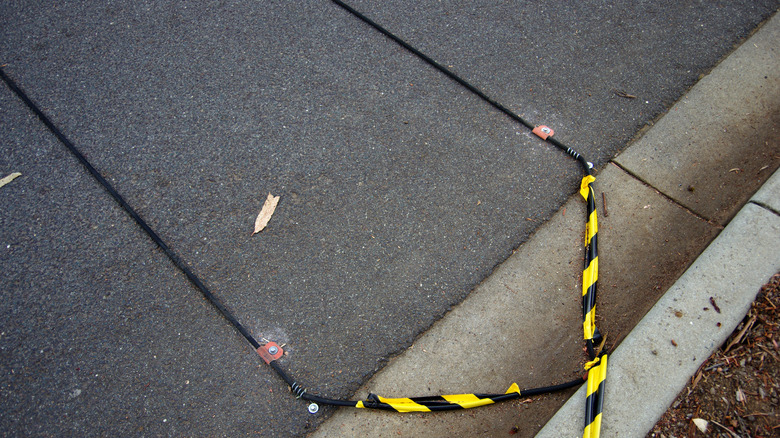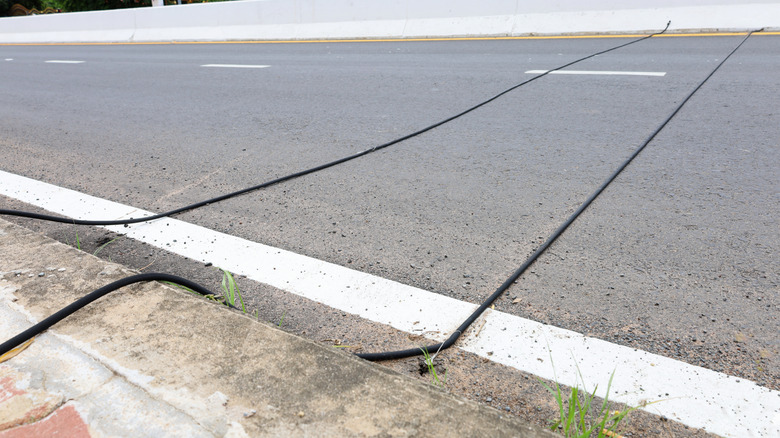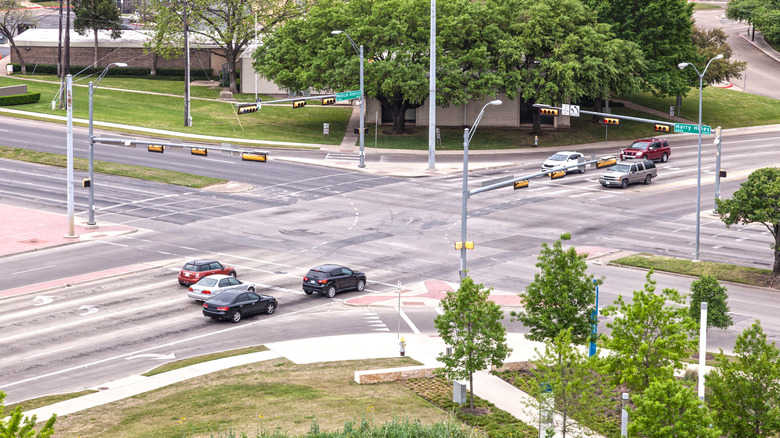Here's What Those Black Cables On The Road Are Actually For
When you're driving along a suburban or small town road, there are certain differences you might notice from other kinds of roads, like highways. In particular, when driving through a high-traffic area like an intersection, you might spot one or two thin, black cables running from one sidewalk to the other, crossing over the road you're about to drive over. These cables are generally small enough that you barely feel your car moving over them, and if you didn't see them, you might not even know they were there.
These black cables are pneumatic road tubes, and they're a vital instrument for local governments to measure the state of traffic in their towns and cities. Unlike something like cameras installed on traffic lights, pneumatic road tubes utilize much simpler air-based technology to measure the number of cars coming and going in a given period, as well as the speed at which they're driving. This information can be used to identify problems like road congestion and get important development projects like road redesigns in motion.
Pneumatic road tubes are activated by the pressure of a passing car
A pneumatic road tube uses a very simple form of measurement and registration, one that has also been used to control traffic lights that detect cars: good old-fashioned airflow.
Pneumatic road tubes are laid out on a road, either poking up out of the pavement or installed just below the surface, where they're powered by a portable energy source like a lead-acid battery. The tubes are then snaked over to a receiver, which is usually equipped with either a simple counter mechanism or more elaborate analysis software. When a car drives over a tube, the weight of the vehicle sends a short burst of air through it. This burst of air changes the air pressure flowing through the tube, closing an electronic air switch. When the switch is closed, the receiver receives a pulse and registers it. As it takes the weight of a car to generate the air burst and subsequent pulse, the number of times the air switch goes off can be correlated to the number of cars that have passed by.
A single pneumatic road tube is enough to determine how many cars have passed over a given spot, but occasionally, there may be two tubes placed a short distance apart from one another. When you have two tubes in play, they can be used to measure speed in addition to the number of cars passing. A vehicle moving over the first tube starts the clock, and the time it takes for it to run over the second tube determines how quickly the vehicle is moving, alongside other relevant info like how large it is or how many axles it has.
Pneumatic road tubes help gather information about traffic patterns
Pneumatic road tubes are a vital instrument of public data gathering for state and local governments. Compared to more elaborate measures like cameras and sensors, they're dirt-cheap to purchase and install, and can be picked up and placed on just about any stretch of road or intersection. You may need more advanced software than just a counting mechanism if you want to know anything beyond the number of cars passing by, though the manufacturers of pneumatic road tubes may bundle such software with their packages.
As for what the information gathered by pneumatic road tubes can be used for, they're mostly for gauging traffic and travel trends. Let's say, for example, a town government has been getting some complaints about a particular intersection and its constant congestion problems, or dangerous designs that could lead to fatal intersection accidents if left unchecked. They can't go on simple complaints before rebuilding the road, so the tubes are laid down to gather data. From the tubes, they can see that a large number of cars are passing through, and at a particularly slow or dangerously fast rate. With this data as justification, the town can rebuild the intersection, widening it or changing its shape or lanes to reduce congestion and improve traffic flow and safety for residents.


